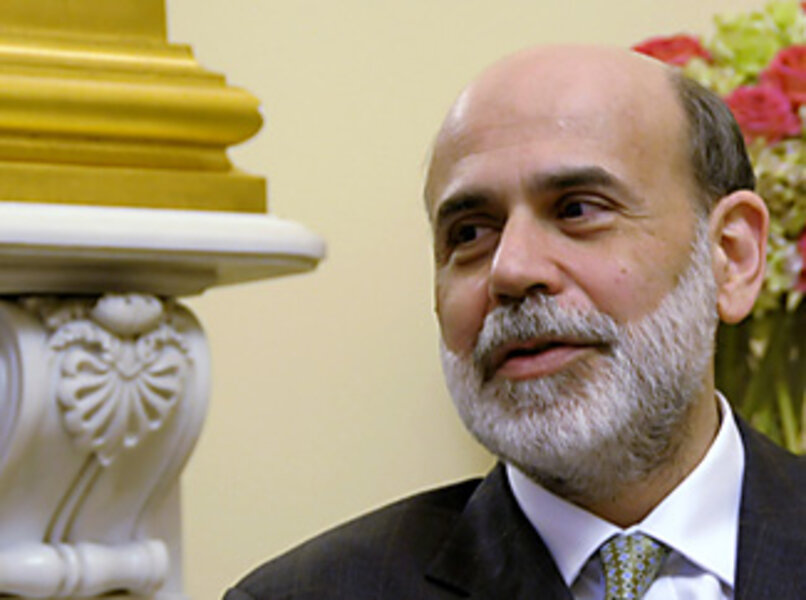The inflation squeeze tightens
Loading...
| New York
Inflation is starting to take its toll on the economy.
Almost anyone who drives knows it costs more to tank up than a year ago. Add in higher prices at the grocery store or the specialty-food shop, and consumers are beginning to feel the impact on their wallets. Higher food and energy costs are the main reasons that inflation last year was at its highest level in 17 years – a galloping 4.1 percent as measured by the consumer price index.
"The middle class is getting squeezed," says Scott Brown, chief economist at Raymond James & Associates in St. Petersburg, Fla.
The rising cost of living is a big reason that holiday sales were disappointing, economists say. Consumers, faced with lower wages and higher prices, are shopping less. Disposable income is shrinking. Last year, wages fell 0.9 percent after adjusting for inflation, says Mr. Brown.
"Real purchasing power is being constrained," he says.
On Wednesday, the extent of this economic squeeze became more apparent when the government reported the December CPI as well as the results for the full year. For December, inflation rose 0.3 percent, down from 0.8 percent in November. But, over the past three months, inflation has grown at a 2.7 percent annual rate.
"These numbers clearly reveal disturbingly high levels of inflation, due mainly to a surge in energy prices in the second half," says Richard DeKaser, chief economist at National City Corp. in Cleveland. "Even removing food and energy, the level is clearly at the high level of the Federal Reserve's comfort zone."
If the inflation trend were to continue, some economists believe it could complicate the Federal Reserve's efforts to stimulate the economy. The Fed tries to balance its role as the nation's chief inflation-fighter with efforts to keep the economy growing.
"The core inflation rate, the rate of inflation without factoring in food and energy, is running at a 2.4 percent annual rate, which is a little bit uncomfortable but not draconian, not a policy stopper," says Bob Brusca of Fact and Opinion Economics in New York.
Because the core rate of inflation has been relatively tame, economists still expect the Fed will lower interest rates by half of a percentage point when it meets at the end of January. "The Fed has indicated it is willing to look the other way, at least for the moment," says Mr. DeKaser. "The Fed has the leisure to go soft on inflation at the moment because it has credibility from its past efforts."
When the Fed looks at inflation, one of its chief concerns is inflationary expectations. For example, it looks at the financial market's expectations about the long-term inflation rate. DeKaser says. At the moment, the bond market is expecting inflation to remain at about 2.3 percent over the next five to 10 years. "That is pretty much where it has been for some time," he adds.
The Fed also looks at consumer surveys of inflation expectations. In November, the Conference Board, a business research group, saw a spike in inflation concerns that mirrored a sharp increase in gasoline prices. In December, inflation concerns eased slightly. But, since then the price of gasoline has climbed about 10 cents a gallon at the pump.
"We would not expect an easing of inflationary expectations," says Lynn Franco, director of the Conference Board's Consumer Research Center in New York. "And with the weather turning colder, heating bills will also tick up, which will put added pressure on consumers."
Inflation per se still hasn't shown up as a problem in polling data, says Dennis Jacobe, chief economist at the Gallup Organization in Washington. "When you ask, people are concerned about college costs, healthcare expenses, and energy, but for some reason that's not translated into a broad concern," says Mr. Jacobe. "I think there is more of a concern about weakness in the economy than about inflation."
However, he thinks that is about to change. "Inflation is a building concern and I would expect it will show up in our surveys more going forward," he says.
The last time the US annual inflation rate was higher was in 1990, when it stood at 6.1 percent. The main reason for this inflation spike was a run-up in the price of oil after Saddam Hussein invaded Kuwait. The US and its allies then pushed Mr. Hussein out.
Back in 1990, the Federal Reserve discounted the run-up in oil prices and cut interest rates. "They were motivated by concerns about economic decline," recalls DeKaser. "They could do this because when oil prices rise it has a debilitating effect on the economy, this causes the unemployment rate to rise and that will relieve inflation pressures," he explains.
In the past year, energy costs were up 17.4 percent while food costs rose 4.9 percent. For the past six months, according to the Bureau of Labor Statistics, some of the sharpest price increases have been for fruits and vegetables, dairy products, fuel oil, and medical care. However, prices have come down for electronics, cars, and household furniture.





